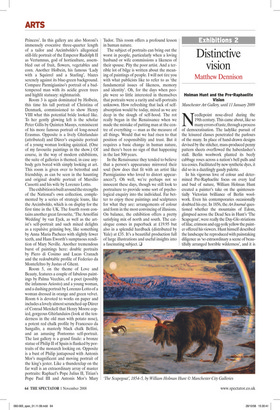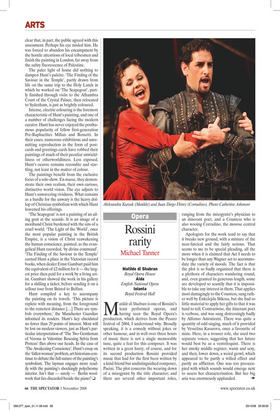Distinctive vision
Matthew Dennison
Holman Hunt and the Pre-Raphaelite Vision Manchester Art Gallery, until 11 January 2009 Needlepoint nose-dived during the 19th century. This came about, like so many errors of taste, through a process of democratisation. The ladylike pursuit of the leisured classes penetrated the parlours of the many. In place of hand-drawn designs devised by the stitcher, mass-produced penny pattern sheets overflowed the haberdasher’s stall. Berlin woolwork planted its beefy cabbage roses across a nation’s bell pulls and tea cosies. Facilitated by new synthetic dyes, it did so in a dazzlingly gaudy palette.
In his vigorous love of colour and determined Pre-Raphaelite focus on every leaf and bud of nature, William Holman Hunt created a painter’s take on the quintessentially Victorian brilliance of Berlin woolwork. Even his contemporaries occasionally doubted his eye. In 1856, the Art Journal questioned whether the mountains of Edom, glimpsed across the Dead Sea in Hunt’s ‘The Scapegoat’, were really the Day-Glo striations of lilac, crimson and egg-yolk yellow the painter offered his viewers. Hunt himself described the landscape he reproduced with painstaking diligence as ‘so extraordinary a scene of beautifully arranged horrible wilderness’, and it is clear that, in part, the public agreed with this assessment. Perhaps his eye misled him. He was forced to abandon his encampment by the hostile attentions of local tribesmen and finish the painting in London, far away from the sultry fluorescence of Palestine.
The paler light of home did nothing to dampen Hunt’s palette. ‘The Finding of the Saviour in the Temple’, partly drawn from life on the same trip to the Holy Lands in which he worked on ‘The Scapegoat’, partly finished through visits to the Alhambra Court of the Crystal Palace, then relocated to Sydenham, is just as brightly coloured.
Intense, electric colouring is the foremost characteristic of Hunt’s painting, and one of a number of challenges facing the modern curator. Hunt has never enjoyed the posthumous popularity of fellow first-generation Pre-Raphaelites Millais and Rossetti. In their cases, numerous exhibitions and unremitting reproduction in the form of postcards and greetings cards have robbed their paintings of much of their peculiar unwieldliness or otherworldliness. Less exposed, Hunt’s oeuvre remains recondite and startling, not least in the matter of colour.
The paintings benefit from the exclusive focus of a solo show. En masse, they demonstrate their own realism, their own curious, distinctive world vision. The eye adjusts to Hunt’s unwavering vividness. What remains as a hurdle for the unwary is the heavy dollop of Christian symbolism with which Hunt leavened his offerings.
‘The Scapegoat’ is not a painting of an ailing goat at the seaside. It is an image of a moribund Christ burdened with the sins of a cruel world. ‘The Light of the World’, once the most popular painting in the British Empire, is a vision of Christ reawakening the human conscience, painted, as the evangelical Hunt recorded, ‘by divine command’. ‘The Finding of the Saviour in the Temple’ earned Hunt a place in the Victorian record books, when dealer Ernst Gambart paid him the equivalent of £2 million for it — the largest price then paid for a work by a living artist. Gambart showed the work in his gallery for a shilling a ticket, before sending it on a sellout tour from Bristol to Belfast.
Hunt compiled a key to accompany the painting on its travels. ‘This picture is replete with meaning, from the foreground to the remotest distance [...] There are symbols everywhere,’ the Manchester Guardian informed its readers. Hunt’s key elucidated no fewer than 29 points of interest. Most will be lost on modern viewers, just as Hunt’s particular interpretation of ‘The Two Gentleman of Verona in Valentine Rescuing Sylvia from Proteus’ flies above our heads. In the case of ‘The Awakening Conscience’, Hunt’s essay on the ‘fallen woman’ problem, art historians continue to debate the full nature of the painting’s symbolism. The layman engages more readily with the painting’s shockingly polychrome interior. Isn’t that — surely — Berlin woolwork that lies discarded beside the piano? ❑



































































































 Previous page
Previous page